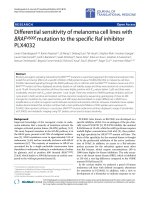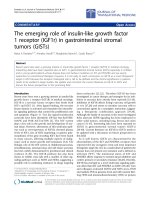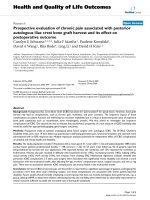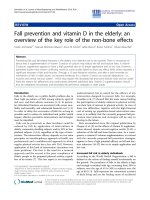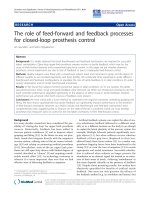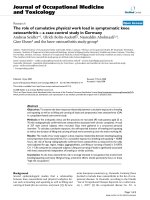Báo cáo hóa học: " The role of perfusion CT in identifying stroke mimics in the emergency room: a case of status epilepticus presenting with perfusion CT alterations" pdf
Bạn đang xem bản rút gọn của tài liệu. Xem và tải ngay bản đầy đủ của tài liệu tại đây (298.44 KB, 4 trang )
CAS E REP O R T Open Access
The role of perfusion CT in identifying stroke
mimics in the emergency room: a case of status
epilepticus presenting with perfusion CT
alterations
Waldo R Guerrero
*
, Haitham Dababneh and Stephan Eisenschenk
Abstract
Emergency medicine physicians are often faced with the challenging task of differentiating true acute ischemic
strokes from stroke mimics. We present a case that was initially diagnosed as acute stroke. However, perfusion CT
and EEG eventually led to the final diagnosis of status epilepticus. This case further asserts the role of CT perfusion
in the evaluation of patients with stroke mimics in the emergency room setting.
Background
The differentiation between stroke and seizure can be a
clinically arduous task for both emergency medicine
physicians and neurologists [1,2]. Patients with diseases
that mimic stroke account for one-fifth of patients wit h
brain attacks [1]. Imaging may therefore be critical in
making a diagnosis in the acute setting. Seizure is one
condition that can mimic a stroke. Commonly, patients
with Todd’s paralysis or those with nonconvulsive status
epilepticus can be clinically indistinct from those with
acute stroke. Further complicating t he clinical scenario,
seizuremayalsobeapresentingsignofstroke[3].
Recently the time frame for standa rd treatment of ac ute
stroke with IV tissue plasminogen activator was
expanded from 3 h to 4.5 h from ictus onset [4].
Although this extension of time is supported by the
American Heart Association, it is not FDA approved
and comes with a different set of relative contraindica-
tions. Intravenous thrombolytics are not without the
risk of complications, including intracranial hemorrhage
[5]. Non-contrast CT (NCCT) of the head is the current
gold standard in excluding intracranial hemorrhage
prior to administration of intravenous thrombolysis.
However, NCCT has a limited role in differentiating
those patients with stroke from those with seizure.
Although current guidelines advocate only NCCT as the
imaging modality of choice in the initial evaluation of
acute stroke, this case illustrates the importance of CT
perfusion studies in the radiographic evaluation of brain
attack patients in order to avoid misdiagnosis and inad-
vertent treatment of non-stroke patients with thrombo-
lytic therapy. F urthermore, whereas hypoperfusion
related to strokes has been widely investigated by CT-
perfusion imaging [ 6,7], this case demonstrates the
hyperperfusion state often seen on perfusion CT in
emergency room patients with epilepsy. We descr ibe an
interesting case of a patient presenting to the Shands
Hospital at the University of Florida emergency room
with a homonymous hemianopsia and alterations on
perfus ion CT related to hyperglycemia-induced occipital
status epilepticus.
Case presentation
A 72-year-old man with a past medical history signifi-
cant for diabetes mellitus type 2 presented to the
Shands Hospital at the University of Florida emergency
room with sudden onset of visual changes. The patient
had noted that he would miss objects when reaching for
them at home. He also noted black and red spots and
prisms in his vision. There was no previous history of
seizures. His risk factors for stroke included his age, dia-
betes type 2, as well as tobacco use. The NIH Stroke
Scale score on presentation was 2 with a complete left
* Correspondence:
Department of Neurology, College of Medicine, University of Florida, 1601
Archer Road Gainesville, 32610-0236 FL, USA
Guerrero et al. International Journal of Emergency Medicine 2012, 5:4
/>© 2012 Guerrero et al; licensee Springer. This is an Open Acc ess article distri bute d under the terms of the Creative Commons
Attribution Licens e ( nses/by/2.0), which pe rmits unrestricted use, distribution, and reproduct ion in
any medium, provided the original work is properly cited.
homonymous hemianopsia. He presented within 3 h of
symptom onset, and perfusion CT was obtained per the
stroke protocol at our institutio n. Non-contrast CT did
not reveal any early signs of stroke or hemorrhage. The
CT angiogram was unremarkable. Perfusion CT demon-
strated an area of shortened mean transit time (MTT),
increased cerebral blood volume (CBV), and increased
cerebral blood flow (CBF) in the right occipita l territory
(Figure 1). Given the patient’s left homonymous hemia-
nopsia, the findings on perfusion CT were interpreted as
a hyperperfusion phenomenon. The differential
diagnosis included epileptiform activity as well as other
pathologies n ot limited to glioma and misery perfusion
syndrome. Thus, an EEG was obtained, and it confirmed
nonconvulsive seizure activity from the right parieto-
occipital quadrant. This patient was eligible for intrave-
nous thrombolysis given the neurological findings and
NIHSS of 2; however, the constellation of the above
findings led to our clinical decision not to administer
thrombolytics in the setting of a seizure diagnosis. The
patient was loaded with Ativan, Fosphenytoin, and
Depakote in order to stop the seizures. Once the
Figure 1 CT perfusion study demonstrating (a) shortened mean transit time in the right occipital territory (arrow). Corresponding area
of increased cerebral blood volume (b) and increased cerebral blood flow (c). FLAIR MRI brain (d) without evidence of infarct.
Guerrero et al. International Journal of Emergency Medicine 2012, 5:4
/>Page 2 of 4
seizures were controlled, the patient’s neurological exam
normalized. Follow-up FLAIR MRI brain imaging did
not reveal evidence of stroke (Figure 1).
Discussion
Stroke mimics account for 5-30% of “brain attacks.” Of
those patients receiving thrombol ytic therapy in the Eur-
opean Cooperative Acute Stroke Study II (ECASS II), 17%
were ultimately shown to not have had strokes [8]. Com-
mon conditions such as migraine, epilepsy with and with-
out Todd’s paralysis, hypoglycemia, and sinus thrombosis
can often mimic stroke [9,10]. Unfortunately, NCCT is
not a sensitive radiographic tool in detecting stroke
because parenchymal changes do not usually appear early
in the course of acute stroke [1,11]. MRI would offer good
accuracy and sensitivity in such cases [12]. However, it is
often not utilized because of its decreased availability in
contrast to the short acquisition time and wide availability
for NCCT in the emergency room setting.
There are data su pporting the use of CT perfusion in
acute stro ke management [11]. Relativ e MTT and abso-
lute CBV are CT perfusion p arameters that help define
areas of infarct from areas of penumbra [6]. Its use has
also been investigated for the di agnosis of seizures
[13,14]. Hauf et al. demonstr ated that perfusion CT is a
useful tool in accelerating the diagnosis of nonconvul-
sive status epilepticus with a sensitivity of 78% [15]. In
this case, cortical hyperperfusion was observed as
reflected by a decrease in mean transient time (MTT)
and a concomitant in crease in cerebral blood volume
(CBV) and flow (CBF) (Figure 1). This is compatible
with previous data demonstrating increased CBV and
CBF values in the seizure o nset zone as well as in the
regions with ictal spread [13]. This hyper perfusion state
during the ictal state has also been shown with SPECT
and f-MRI in patients with focal epilepsy [16,17].
CT perfusion has the advantages of routine availabil-
ity, short acquisition time, and quantitative resul ts. This
case further supports the role of CT perfusion in the
emergency room setting when assessing stroke patients
for thrombolytics. Although patients with stroke mimics
infrequently receive thrombolytics and their treatment
generally does not lead to harmful complications [18],
CT perfusion may spare p atients with status e pilepticus
from the misguided treatment of intravenous thrombo-
lysis. PCT may also qualify as a complementary diagnos-
tic tool in patients presenting to the emergency room
with altered mental status in which stroke is also a con-
sideration for etiology.
Conclusions
In summary, perfusion CT can serve an important role
in differentiating acute stroke from an unusual presenta-
tion of status epilepticus in the emergency room setting.
Consent
Written informed consent was obtained from the patient
for publicatio n of this case report and any accompany-
ing images. A copy of the writ ten consent is availabl e
for review by the Editor-in-Chief of this journal.
Abbreviations
NCCT: non-contrast CT head, MTT: mean transit time. CBV: cerebral blood
volume, CBF: cerebral blood flow, SPECT: single-photon emission computed
tomography, f-MRI: functional magnetic resonance imaging.
Acknowledgements
Publication of this article was funded in part by the University of Florida
Open-Access Publishing Fund.
Authors’ contributions
WG drafted the manuscript and collected the images and figure utilized in
this manuscript. HD edited the manuscript and assisted in CT perfusion
image interpretation. SE edited the manuscript as well as supervised. All
authors read and approved the final manuscript.
Authors’ information
WG and HD are both fourth year Neurology residents at the University of
Florida. SE is Associate Professor of Neurology, Clinical Director, Adult
Neurology Comprehensive Epilepsy Program, and Medical Director, UF &
Shands Epilepsy Monitoring Unit.
Competing interests
The authors declare that they have no competing interests.
Received: 7 November 2011 Accepted: 20 January 2012
Published: 20 January 2012
References
1. Davis DP, Robertson T, Imbesi SG: Diffusion-weighted magnetic resonance
imaging versus computed tomography in the diagnosis of acute
ischemic stroke. J Emerg Med 2006, 31(3):269-277.
2. Scott PA, Silbergleit R: Misdiagnosis of stroke in tissue plasminogen
activator-treated patients: characteristics and outcomes. Ann Emerg Med
2003, 42(5):611-618.
3. Selim M, Kumar S, Fink J, Schlaug G, Caplan LR, Linfante I: Seizure at stroke
onset: is it an absolute contraindication to thrombolysis. Cerebrovasc Dis
2002, 14:54-7.
4. Hacke W, Kaste M, Bluhmki E, Brozman M, Dávalos A, Guidetti D, Larrue V,
Lees KR, Medeghri Z, Machnig T, Schneider D, von Kummer R, Wahlgren N,
Toni D, ECASS Investigators: Thrombolysis with alteplase 3 to 4.5 hours
after acute ischemic stroke. N Engl J Med 2008, 359(13):1317-29.
5. The National Institute of Neurological Disorders and Stroke rt-PA Stroke
Study Group: Tissue plasminogen activator for acute ischemic stroke. N
Engl J Med 1995, 333:1581-7.
6. Wintermark M, Flanders AE, Velthuis B, Meuli R, van Leeuwen M,
Goldsher D, Pineda C, Serena J, van der Schaaf I, Waaijer A, Anderson J,
Nesbit G, Gabriely I, Medina V, Quiles A, Pohlman S, Quist M, Schnyder P,
Bogousslavsky J, Dillon WP, Pedraza S: Perfusion-CT assessment of infarct
core and penumbra: receiver operating characteristic curve analysis in
130 patients suspected of acute hemispheric stroke. Stroke 2006,
37(4):979-85.
7. Murphy BD, Fox AJ, Lee DH, Sahlas DJ, Black SE, Hogan MJ, Coutts SB,
Demchuk AM, Goyal M, Aviv RI, Symons S, Gulka IB, Beletsky V, Pelz D,
Hachinski V, Chan R, Lee TY: Identification of penumbra and infarct in
acute ischemic stroke using computed tomography perfusion-derived
blood flow and blood volume measurements. Stroke Jul 2006,
37(7):1771-7.
8. Hacke W, Kaste M, Fieschi C, von Kummer R, Davalos A, Meier D, Larrue V,
Bluhmki E, Davis S, Donnan G, Schneider D, Diez-Tejedor E, Trouillas P:
Randomised double-blind placebo-controlled trial of thrombolytic
therapy with intravenous alteplase in acute ischaemic stroke (ECASS II).
Guerrero et al. International Journal of Emergency Medicine 2012, 5:4
/>Page 3 of 4
Second European-Australasian Acute Stroke Study Investigators. Lancet
1998, 352(9136):1245-51.
9. Hemmen TM, Meyer BC, McClean TL, Lyden PD: Identification of
nonischemic stroke mimics among 411 code strokes at the university of
california, san Diego, stroke center. J Stroke Cerebrovasc Dis 2008,
17(1):23-25.
10. Hand PJ, Kwan J, Lindley RI, Dennis MS, Wardlaw JM: Distinguishing
between stroke and mimics at the bedside. Stroke 2006, 37:769-775.
11. Wintermark M, Reichhart M, Thiran JP, Maeder P, Chalaron M, Schnyder P,
Bogousslavsky J, Meuli R: Prognostic accuracy of cerebral blood flow
measurement by perfusion computed tomography, at the time of
emergency room admission, in acute stroke patients. Ann Neurol 2002,
51:417-432.
12. Lam WW, Wong KS, Rainer TH, So NM: Assessment of hyperacute stroke
like symptoms by diffusion-weighted images. Clin Imaging 2005,
29(1):6-9.
13. Wiest R, von Bredow F, Schindler K, Schauble B, Slotboom J, Brekenfeld C,
Remonda L, Schroth G, Ozdoba C: Detection of regional blood perfusion
changes in epileptic seizures with dynamic brain perfusion CT- A pilot
study. Epilepsy Res 2006, 72(2-3):102-110.
14. Mathews MS, Smith WS, Wintermark M, Dillon WP, Binder DK: Local cortical
hypoperfusion imaged with CT perfusion during postictal Todd’s paresis.
Neuroradiology 2008, 50(5):397-401.
15. Hauf M, Slotboom J, Nirkko A, von Bredow F, Ozdoba C, Wiest R: Cortical
regional hyperperfusion in nonconvulsive status epilepticus measured
by dynamic brain perfusion CT. AJNR Am J Neuroradiol 2009, 30(4):693-8.
16. Markand ON, Salanova V, Worth R, Park HM, Wellman HN: Comparative
study of interictal PET and ictal SPECT in complex partial seizures. Acta
Neurol Scand 1997, 95:129-36.
17. Carrera E, Michel P, Despland PA, Maeder-Ingvar M, Ruffieux C, Debatisse D,
Ghika J, Devuyst G, Bogousslavsky J: Continuous assessment of electrical
epileptic activity in acute stroke. Neurology 2006, 67(1):99-104.
18. Artto V, Putaala J, Strbian D, Meretoja A, Piironen K, Liebkind R,
Silvennoinen H, Atula S, Häppölä O, Helsinki Stroke Thrombolysis Registry
Group: Stroke mimics and intravenous thrombolysis. Ann Emeg Med 2012,
59(1):27-32.
doi:10.1186/1865-1380-5-4
Cite this article as: Guerrero et al.: The role of perfusion CT in
identifying stroke mimics in the emergency room: a case of status
epilepticus presenting with perfusion CT alterations. International Journal
of Emergency Medicine 2012 5:4.
Submit your manuscript to a
journal and benefi t from:
7 Convenient online submission
7 Rigorous peer review
7 Immediate publication on acceptance
7 Open access: articles freely available online
7 High visibility within the fi eld
7 Retaining the copyright to your article
Submit your next manuscript at 7 springeropen.com
Guerrero et al. International Journal of Emergency Medicine 2012, 5:4
/>Page 4 of 4




